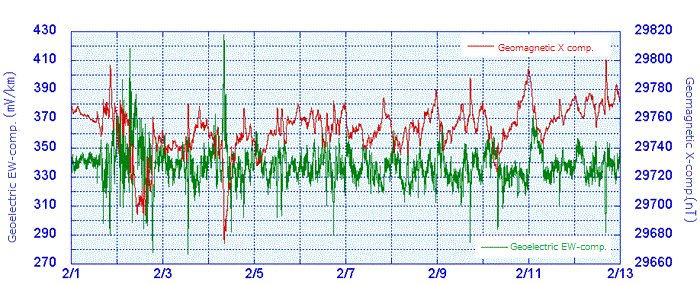Weak geoelectric currents are monitored from differences in potential between underground electrodes. Such observation is conducted in various fields, including subsurface structural exploration, where natural changes such as geomagnetic induction and crustal activity can be clarified.

−Geoelectric field observation−
When electric currents fluctuate in the ionosphere and magnetosphere due to solar and other influences, geomagnetic fields also fluctuate, which induces counteractive geoelectric fields in the ground.

−North-south geomagnetic field components (red) and east-west geoelectric field components (green) as observed at the Kakioka Observatory in February 2003−
Short-period variations exhibit a correlation of mutually orthogonal components in both fluctuations.
The degree of underground geoelectric currents relating to geomagnetic fields depends on related electrical currents. Accordingly, subsurface electrical properties can be analyzed from the causal relation between geomagnetic and geoelectric field variations. This magnetotelluric approach is widely used in the exploration of underground resources and subsurface structures, such as faults, volcanoes and plates.
Where there is active crustal activity such as earthquakes and volcanoes, electrical fluctuations occur due to factors such as fluctuations in ground stress, ground temperature and groundwater.
Subsurface electrical properties change with crustal activity events such as temperature fluctuations and water/mass movement, resulting in changes in resistivity (the ratio of electrical to magnetic variation). Such small resistivity changes are difficult to detect with typical resolutions of observation based on natural electromagnetic field fluctuations. As a result, various techniques based on controlled electric current in the ground are used.
The DC component of the geoelectric field (referred to as self-potential) is distinguished from induced geoelectric fields associated with upper-atmospheric fluctuations. Self-potential variations can result from streaming potential, which reflects electrokinetic phenomena caused by groundwater flow. Self-potential is therefore an observable used to estimate subsurface conditions, such as in earthquake faults where stress varies, and in volcanic areas where hydrothermal systems vary with magma-related heat.
Copyright (c) Kakioka Magnetic Observatory, Japan Meteorological Agency. All rights reserved.
